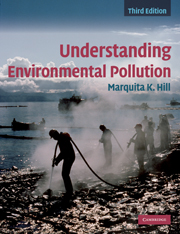Book contents
- Frontmatter
- Contents
- Preface
- Acknowledgements
- List of abbreviations and acronyms
- 1 Understanding pollution
- 2 Reducing risk, reducing pollution
- 3 Chemical toxicity
- 4 Chemical exposures and risk assessment
- 5 Air pollution
- 6 Acid deposition
- 7 Global climate change
- 8 Stratospheric ozone depletion
- 9 Water pollution
- 10 Drinking-water pollution
- 11 Solid waste
- 12 Hazardous waste
- 13 Energy
- 14 Persistent, bioaccumulative, and toxic
- 15 Metals
- 16 Pesticides
- 17 Pollution at home
- 18 Zero waste, zero emissions
- 19 Chemistry: some basic concepts
- Index
- References
18 - Zero waste, zero emissions
Published online by Cambridge University Press: 05 June 2012
- Frontmatter
- Contents
- Preface
- Acknowledgements
- List of abbreviations and acronyms
- 1 Understanding pollution
- 2 Reducing risk, reducing pollution
- 3 Chemical toxicity
- 4 Chemical exposures and risk assessment
- 5 Air pollution
- 6 Acid deposition
- 7 Global climate change
- 8 Stratospheric ozone depletion
- 9 Water pollution
- 10 Drinking-water pollution
- 11 Solid waste
- 12 Hazardous waste
- 13 Energy
- 14 Persistent, bioaccumulative, and toxic
- 15 Metals
- 16 Pesticides
- 17 Pollution at home
- 18 Zero waste, zero emissions
- 19 Chemistry: some basic concepts
- Index
- References
Summary
“The time has come for humankind not to expect the Earth to produce more, but rather to do more with what the Earth already produces.”
Gunter Pauli, Belgian industrialistRemember the concept of nature's services from Chapter 1: conserving nature is absolutely necessary to the sustaining of meaningful life on Earth, its habitats and biodiversity, and its ability to continue to perform the services on which humanity and all life depends. Sustaining nature's services necessitates producing a minimal amount (“zero”) of damaging wastes and emissions. The Product Life Institute provides a worthwhile introduction to sustainability; see footnote. But how can we speak of zero waste or zero emissions if, as you learned earlier, no process is 100% efficient? The answer is that zero waste is a philosophy, one that says there is no waste: What we call “waste” or “pollutant” is really a useful resource. However, this philosophy recognizes that waste is now a major problem and, if we aspire to reduce waste 100%, we accomplish more than if our goal was 40% or 80%. Thinking of wastes and pollution in this manner is not contradictory to other concepts covered in this book such as pollution control and pollution prevention because humanity is working at a number of levels, both doing what we must at the present while also working toward the future vision of finding means to a sustainable environment and world.
- Type
- Chapter
- Information
- Understanding Environmental Pollution , pp. 511 - 538Publisher: Cambridge University PressPrint publication year: 2010

